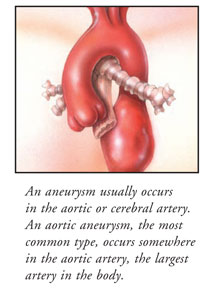
A Bulge in the Artery May Result in Rupture
Diabetes affects many organs in the body and causes complications that can be serious and irreversible. When blood sugar is not tightly controlled, the organs can suffer severe damage. By carefully An aneurysm is a bulge in an artery wall, usually in an area that is weakened by atherosclerotic changes (hardening of the arteries). The pressure of the blood flowing through the artery can push the weakened part of the wall outward, causing the bulge to grow larger with time. Although atherosclerosis can be the cause of an aneurysm formation, some people are born with a weak area in an artery wall. Others may develop an aneurysm after an infection of the aorta or after a traumatic injury. The most common aneurysms occur in the aortic artery (aortic aneurysm), a large artery that runs through the abdomen and into the legs, or in one of the cerebral arteries that bring blood to the brain (cerebral aneurysm). An aneurysm may or may not be dangerous, depending on its location and size. A large bulge in a large artery can result in rupture of that artery, causing internal bleeding that can lead to stroke or life-threatening bleeding. But many aneurysms are small, and remain small or very slowly enlarge over time, and are not likely to burst. In most cases, aneurysms do not cause symptoms as they enlarge, except those in very large aortic arteries or cerebral arteries. They are usually detected during a physical examination, a CT (computed tomography) scan, or an MRI (magnetic resonance imaging) scan. In many cases, aneurysms are small and can be watched to determine whether growth occurs; in other cases, surgery is required to clip off the weakened area of the blood vessel to prevent rupture or to stop bleeding after rupture has occurred.
Aneurysms Can Grow and Burst
An aneurysm is a widening or bulge in an artery wall, usually caused by weakening or damage to an area where atherosclerotic changes have occurred. Although these bulges often stay small and do not cause any health risks, some aneurysms do grow larger and pose a threat. In larger arteries, aneurysms can burst under the pressure of the blood flowing through them, causing internal bleeding. Another complication of an aneurysm is the release of small blood clots, which can travel through the artery and lodge in one or more of its smaller branches, causing pain and poor circulation. Patients at higher risk for aneurysm are those who are genetically prone to this condition, those born with a blood vessel (arteriovenous) malformation, those who smoke, those with high blood pressure or atherosclerosis (hardening of the arteries), or those suffering from an infection or traumatic injury to the area. Factors that increase the risk of aneurysm rupture are smoking, heavy alcohol intake, middle age, and a heart defect or kidney disease.
Aortic aneurysms:
An aneurysm is most likely to occur in the aortic or cerebral artery. An aortic aneurysm, the most common type, occurs somewhere in the aortic artery, the largest artery in the body, which stretches from the heart down through the abdomen and splits into the large arteries of each leg. Aortic aneurysms are most often found in the abdomen (abdominal aneurysm), but they can occur in the chest (thoracic aneurysm). They do not usually cause symptoms unless they grow very large (2 to 4 inches wide) or rupture. During a physical examination, an aortic aneurysm may be found by listening to blood flow using a stethoscope or by feeling a pulsating bulge in the abdomen. Abdominal aneurysms may cause back pain, while thoracic aneurysms can cause coughing or hoarseness, problems in swallowing, or swelling in the neck or arms.
When surgery is needed:
Treatment for an aortic aneurysm involves surgery to repair the ballooning out of the blood vessel. Often the treatment is to “watch and wait” to see if the aneurysm grows, which increases its chance of rupture. An aortic aneurysm may be surgically removed, or it can be bypassed through a special procedure in which a stent (wire mesh) is inserted in the artery inside the area that is weakened. The stents are connected by a graft (patch of synthetic material) so that blood can flow through a stable channel. An aortic aneurysm that ruptures is a medical emergency.
Brain aneurysms:
A cerebral (brain) aneurysm is a bulging of the wall of the cerebral artery, the artery that supplies blood to the brain. It is is diagnosed through an angiogram, a CT scan, or an MRI scan. If an aneurysm leaks or bursts inside the brain, causing bleeding into the brain tissue or space around the brain, a stroke or death can result. The primary symptoms of a cerebral aneurysm are headache and vision changes. Warning signs of a ruptured cerebral aneurysm include a moderate headache, seizures, or nausea and vomiting, followed by full-blown headache, stiff neck, vomiting, loss of consciousness, or seizures.
Limit risk factors:
Since there are no specific ways to prevent aneurysms or their rupture, it is wise to limit the risk factors that can be controlled, such as high blood pressure, smoking, and alcohol use. Your doctor may prescribe medications to lower blood pressure or cholesterol levels if you have an aneurysm. Your pharmacist can answer any questions about your medications.






